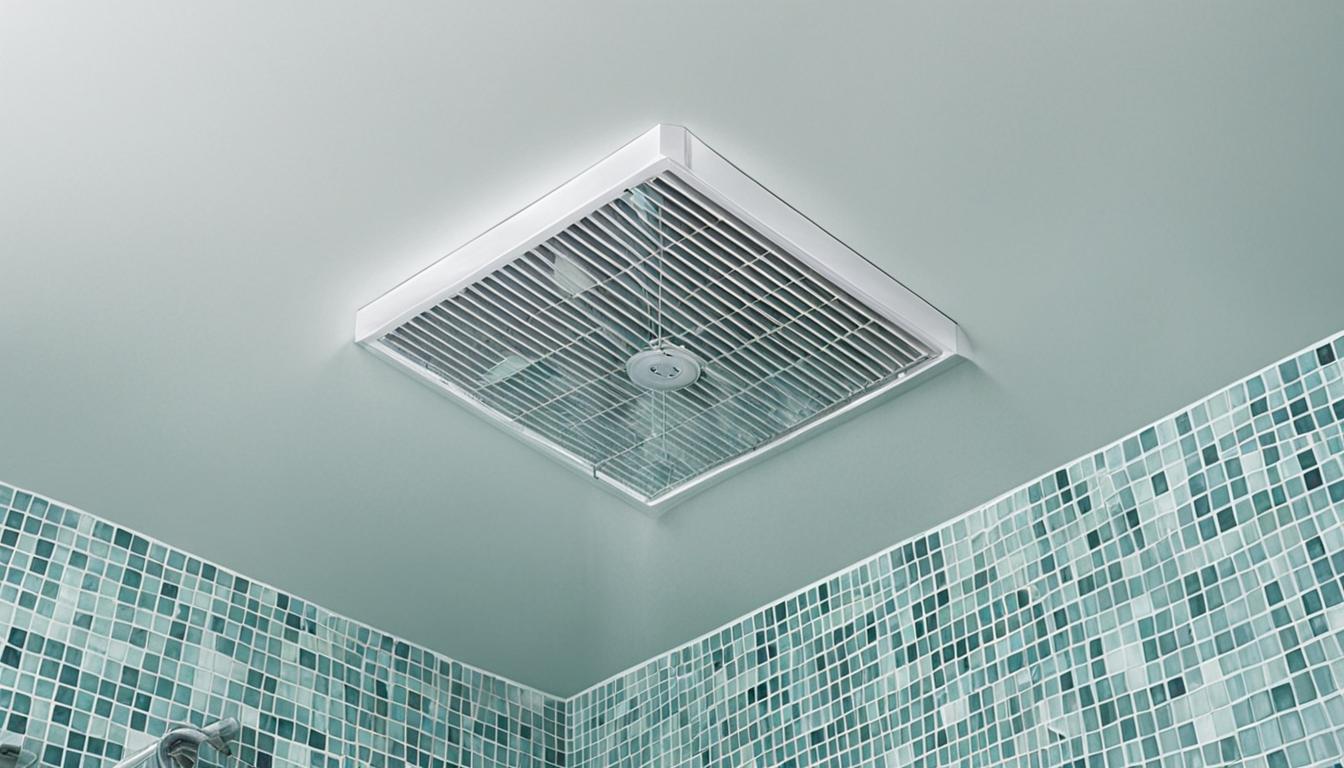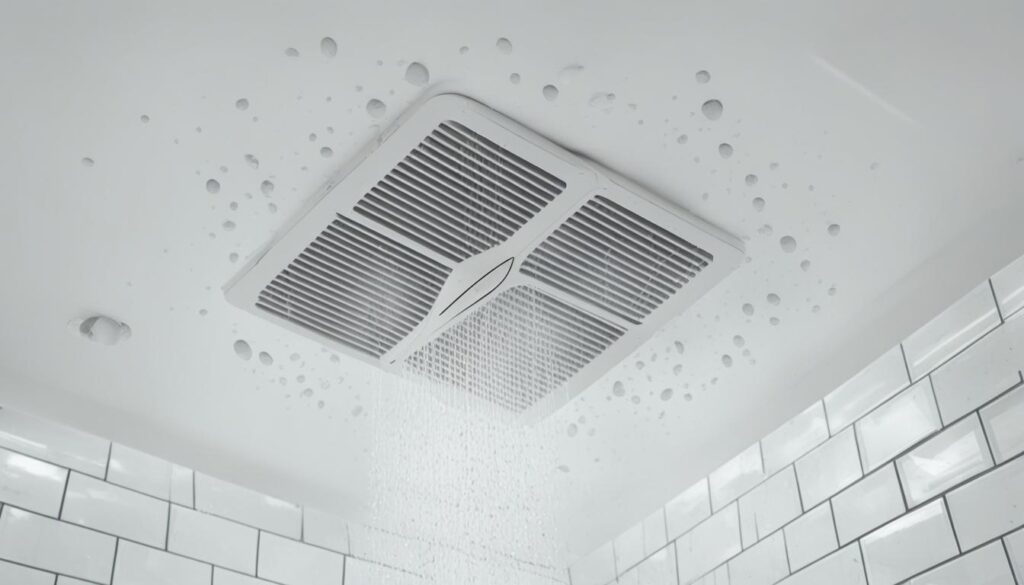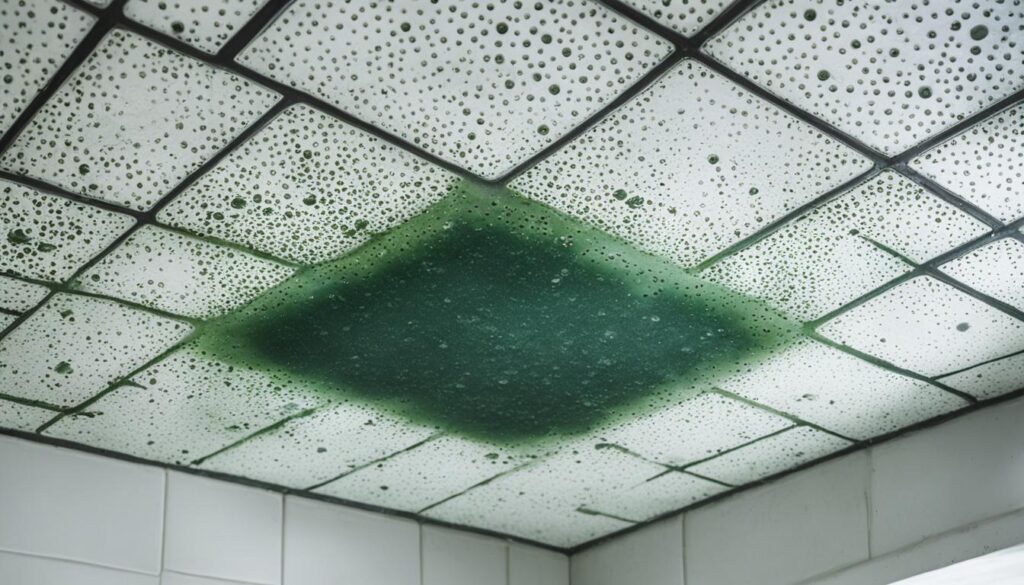
Eliminating Mold on Bathroom Ceiling Above Shower
If you’ve noticed mold growth on your bathroom ceiling above the shower, you’re not alone. Mold thrives in moist, warm environments and can pose a health risk if left unchecked. Fortunately, there are effective strategies for eliminating mold and preventing its return.
In this section, we will discuss practical tips for removing mold from the bathroom ceiling and preventing its regrowth. We will cover essential techniques such as proper ventilation, reducing humidity levels, regular maintenance, and prompt water leak repair.
Key Takeaways:
- High humidity and poor ventilation in a bathroom can cause mold growth on the ceiling above the shower.
- To eliminate mold, use safe and effective cleaning solutions and products.
- Prevention is key to maintaining a mold-free bathroom ceiling.
- Expert tips include choosing mold-resistant materials, installing exhaust fans, and using mold-inhibiting paints or sealants.
- If the mold problem persists or is extensive, consult a professional mold removal company.
Understanding the Causes of Mold Growth
Preventing mold in the bathroom is essential to protect your health and maintain a comfortable living environment. However, before you can prevent mold, it’s important to understand what causes it to grow in the first place. Common factors that contribute to bathroom mold growth include:
- High humidity levels
- Poor ventilation
- Water leaks or moisture buildup
- Lack of regular cleaning and maintenance
High humidity levels are often caused by steam from the shower or bath. When the warm air comes into contact with the cool surfaces in the bathroom, such as the walls, floors, and ceiling, it creates ideal conditions for mold growth. Poor ventilation can be due to a lack of exhaust fans or windows, which prevent proper air circulation and lead to stagnant, humid air. Water leaks and moisture buildup can occur from leaky pipes, overflowing sinks or toilets, and even dripping showerheads. If left unaddressed, this can cause water damage and create mold-friendly environments.
Lack of regular cleaning and maintenance can also contribute to mold growth, as dirt, grime, and soap scum can provide nutrients to mold spores. A buildup of organic matter on surfaces in the bathroom can also create a prime breeding ground for mold.
The Importance of Preventing Mold in the Bathroom
Preventing mold growth in the bathroom is crucial for maintaining a healthy living environment. Exposure to mold can cause a range of health effects, including respiratory problems, allergies, and aggravation of existing conditions like asthma. Mold can also cause damage to your home, including rotting wood and weakening of surfaces, which can lead to expensive repairs. By understanding the causes of mold growth and taking steps to prevent it, you can protect your health and invest in the longevity of your home.
In the next section, we will discuss the signs of mold on the bathroom ceiling above the shower, so you can spot it early and take action to prevent mold growth.
Signs of Mold on the Bathroom Ceiling
Don’t ignore the potential of mold on your bathroom ceiling above the shower. Early detection is essential in preventing mold infestation from spreading and causing damage to your health and home. There are several signs you should be aware of and keep a lookout for:
- Dark patches or discoloration: Mold growth can cause discoloration on your bathroom ceiling. If you see any dark spots or stains that resemble dirt or soot, it may be mold.
- Musty odor: Mold has a distinct, musty smell. If your bathroom has this odor, even after cleaning, it may indicate mold growth on the ceiling.
- Respiratory symptoms: Prolonged exposure to mold spores can lead to respiratory problems like coughing and wheezing. If you or your family members have respiratory symptoms that persist or worsen when you’re in the bathroom, it may be due to mold growth.
If you notice any of these signs, it’s crucial to take prompt action and address the issue. Failure to do so can lead to severe mold infestation that requires professional remediation.
Tip: If you have a bathroom fan, run it during and after your shower to reduce humidity levels and prevent mold growth. If there’s no bathroom fan, leave the bathroom door open for ventilation and consider investing in a dehumidifier.
Removing Mold from the Bathroom Ceiling
If you’ve noticed mold on the bathroom ceiling, it’s essential to take prompt action to remove it. Here are some effective methods for removing mold from your bathroom ceiling:
- Use a cleaning solution: Mix a solution of 1-part water and 1-part bleach or vinegar in a spray bottle. Spray the affected area and let it sit for 15 minutes. Scrub the area with a brush and rinse with water.
- Try a mold removal product: Look for bathroom mold removal products at your local home improvement store. Follow the instructions carefully.
- Use natural remedies: Mix baking soda and water to create a paste. Apply the paste to the affected area and let it sit for a few minutes before scrubbing with a brush.
Whatever method you choose, make sure to wear protective gear, such as gloves and a mask, to avoid inhaling mold spores.
Recommended Bathroom Mold Removal Products
| Product Name | Price | Features |
|---|---|---|
| Concrobium Mold Control | $9.97 | Kills and prevents mold and is safe for use on all surfaces. |
| Mold Armor Instant Mold and Mildew Stain Remover | $5.98 | Powerful bleach-based formula for quick and easy removal of mold stains. |
| Zep Mold Stain and Mildew Stain Remover | $4.97 | Professional strength cleaner that eliminates mold, mildew and stains without scrubbing. |
Note: Always read the labels and follow the instructions carefully when using mold removal products.
Preventing Mold Growth on the Ceiling
Mold prevention is much easier than mold remediation and can save you a lot of money. Here are some practical tips for preventing ceiling mold in your bathroom:
- Proper ventilation: Use an exhaust fan during and after showers. If your bathroom doesn’t have a window, keep the door open to let steam escape.

- Reducing humidity levels: Use a dehumidifier or air conditioner to keep humidity levels below 60%. Fix any water leaks as soon as possible to prevent moisture buildup.
- Regular maintenance: Clean your bathroom regularly to prevent moisture buildup and remove any visible mold on the ceiling or walls. Use a solution of one-part white vinegar to one-part water to wipe down surfaces.
- Addressing water leaks promptly: Check for water leaks regularly, especially around the showerhead, faucet, and tub. Fix any leaks you find immediately to prevent water damage, moisture buildup, and mold growth.
By following these tips, you can significantly reduce the likelihood of mold growth on your bathroom ceiling. However, if you do notice any signs of mold, it’s crucial to take immediate action to prevent it from spreading.
Expert Tips for Long-Term Mold Prevention
While basic prevention techniques can help control mold growth, taking additional steps for long-term prevention can create a healthier home environment. Listed below are expert tips to consider:
- Choose mold-resistant materials: Prevent mold growth by choosing materials designed to resist moisture. Options include mold-resistant drywall, paint, and insulation.
- Install exhaust fans: Proper ventilation is critical in preventing mold growth. Installing exhaust fans in the bathroom and kitchen can help reduce humidity levels and limit moisture exposure.
- Utilize mold-inhibiting paints or sealants: Coating surfaces susceptible to mold growth with mold-resistant paints or sealants can help inhibit mold growth.
By taking these steps, you can effectively prevent mold growth on your bathroom ceiling above the shower, promoting a healthier living environment for you and your family.
“Preventing mold growth is key to maintaining a healthy living environment.”
Hiring Professional Mold Removal Services
If you have a mold problem on your bathroom ceiling that is extensive or recurring, seeking professional mold removal services may be necessary. While DIY removal methods can be effective for small and isolated cases, professional services offer many benefits.
- Expertise: Professional mold removal companies have the knowledge and experience to identify the root cause of the problem and assess the extent of the damage. This ensures that the mold is completely removed, and the risk of future growth is minimized.
- Equipment: Professional companies have specialized equipment, such as industrial-strength disinfectants and air scrubbers, which are essential for effective mold remediation. They also have the necessary protective gear to keep their workers safe during the removal process.
- Time and convenience: Removing mold can be a time-consuming and challenging process. Hiring professionals means that the job can be completed efficiently and without disrupting your daily life.
When selecting a professional mold removal company, it is crucial to choose a reputable and experienced provider. Look for companies with certifications from industry organizations such as the National Organization of Remediators and Mold Inspectors (NORMI) or the Institute of Inspection, Cleaning and Restoration Certification (IICRC).

DIY vs. Professional Mold Removal
When it comes to mold on your bathroom ceiling above the shower, you have two options: handle it yourself or seek professional help. Both have their pros and cons, and it’s important to understand the level of mold infestation, safety considerations, and cost-effectiveness before making a decision.
DIY Mold Removal
Removing mold from the bathroom ceiling is possible with some DIY techniques. This option is ideal for small to medium-size mold problems. The cost is significantly lower than hiring professionals, and the process is convenient as you can do it on your schedule. However, if you have respiratory allergies or chronic lung disease, this option is not recommended since it can exacerbate your symptoms.
If you choose to go the DIY route, the first step is to protect yourself from the mold spores by wearing protective gear. Next, clean the mold with a solution of bleach and water or a commercial mold removal product. Once the area is clean and dry, consider using mold-resistant paint or sealer to prevent future mold growth.
Note: Always follow the manufacturer’s instructions when using cleaning products or protective gear.
Professional Mold Removal
If you have a significant mold problem or recurring mold growth, professionals are best equipped to handle the situation. Professionals have the expertise, tools, and safety protocols to remove the mold safely and effectively. They also have access to advanced techniques such as air filtration and mold testing to ensure comprehensive remediation. However, professional services can be expensive and may require scheduling and coordinating with the contractor.
When choosing a professional mold removal company, make sure to select a reputable and licensed service provider. Check for customer reviews, industry certifications, and proof of liability insurance.
DIY vs. Professional Mold Removal: Summary Table
| DIY Mold Removal | Professional Mold Removal | |
|---|---|---|
| Cost | Lower | Higher |
| Convenience | Flexible | Requires scheduling |
| Safety | Depends on individual’s health condition and proper safety gear | Professional safety protocols and equipment |
| Effectiveness | Effective for small to medium-size mold problems | Effective for significant mold problems and recurring growth |
Ultimately, whether to opt for DIY or professional mold removal depends on the extent of the mold problem, your health condition, budget, and convenience. Regardless of which option you choose, it’s essential to address mold growth promptly to prevent further damage to your property and protect your family’s health.
Conclusion
In conclusion, eliminating mold on the bathroom ceiling above the shower is crucial for creating a healthier living environment. By understanding the common causes of mold growth and recognizing the signs of mold on the ceiling, you can take prompt action to prevent and remove mold. Implementing preventive measures such as proper ventilation, reducing humidity levels, and regular maintenance can help keep your bathroom mold-free in the long run. Remember, if the mold problem persists or is extensive, it is recommended to consult a professional mold removal company. They can provide specialized services and equipment to ensure proper mold remediation and prevention. Contact FixMold at 305-465-6653 today to schedule an assessment and get expert assistance in mold prevention and remediation.
FAQ
How can I prevent mold from forming on the bathroom ceiling above the shower?
To prevent mold growth on the bathroom ceiling above the shower, make sure to adequately ventilate the space by using an exhaust fan or opening windows during and after showering. Additionally, keep the bathroom well-maintained, promptly addressing any water leaks or plumbing issues, and regularly clean the shower area to remove any soap scum or moisture buildup.
What are some effective methods for removing mold from the bathroom ceiling?
To remove mold from the bathroom ceiling, you can mix a solution of equal parts water and white vinegar or use a commercial mold remover. Apply the solution to the affected area, scrub gently with a brush, and then rinse with water. It is essential to wear protective gear, such as gloves and a mask, during the cleaning process to avoid inhaling or touching the mold.
Can I use bleach to remove mold from the bathroom ceiling?
While bleach can effectively kill mold, it may not completely remove it from porous surfaces such as drywall. Additionally, bleach can be harsh and potentially harmful to your health and the environment. It is recommended to use less toxic alternatives, such as vinegar or hydrogen peroxide, for mold removal on the bathroom ceiling.
What should I do if the mold on the bathroom ceiling above the shower keeps coming back?
If mold keeps recurring on the bathroom ceiling above the shower, it is essential to identify and address the underlying cause of the mold growth. Check for any water leaks or excessive moisture in the area and ensure proper ventilation. If the problem persists, consider consulting a professional mold remediation company to assess and fix the issue.
How often should I inspect my bathroom ceiling for signs of mold?
It is advisable to inspect your bathroom ceiling for signs of mold on a regular basis, at least once every month. Look out for any dark patches, discoloration, or musty odors that may indicate the presence of mold. Early detection can help you take prompt action and prevent the mold from spreading further.
Can I prevent mold growth on the bathroom ceiling by using a dehumidifier?
While a dehumidifier can help reduce humidity levels in the bathroom, it may not be sufficient on its own to prevent mold growth on the ceiling. It is recommended to combine the use of a dehumidifier with proper ventilation, regular cleaning, and addressing any water leaks or plumbing issues to effectively prevent mold formation.




